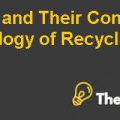
In 2006, Rio Tinto Iron Ore (RTIO) encountered a number of problems. Iron ore business traditionally dominated by a few large suppliers that sell relatively few major steel producers. The business environment is changing, however, with the rapid development of China. Demand is growing faster than supply, which leads to higher prices, especially in the spot market. Most of the products RTIO was committed to implementing long-term contracts, so it can not fully benefit from the high prices on the spot market. New participants, however, were not committed to long-term contracts and were attracted these high prices. In addition, many new Chinese iron and steel plants were small operations, geographically issued, and ensure their supply of iron ore before building their own factories. An important part of the supply chain of iron ore was transportation. Traditionally, customers are responsible for shipping, but it does not meet the needs of small, remotely located Chinese factories. In addition to these changes in the market, RTIO developed a new steelmaking technology that allowed the use of lower-quality iron ore, as well as generate much less greenhouse gas emissions compared to conventional technologies. There are several possible approaches to the commercialization of this technology, ranging from vertical integration to licensing. "Hide
by Hau Lee, David W. Hoyt, Samir Singh Source: Stanford Graduate School of Business 26 pages. Publication Date: July 3, 2007. Prod. #: GS56-PDF-ENG













